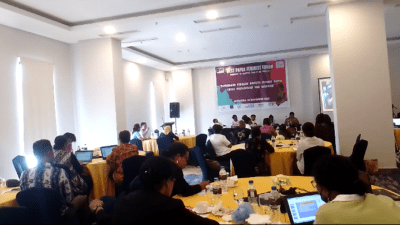
Jakarta, Jubi – It’s not like the other days. That afternoon, the Vertentensai hall of Merauke archdiocese was crowded.
Dozens of children who are misusing Aibon glue conducted medical check-up. Merauke Archdiocese Health Commission, in collaboration with Forum Peduli Penyalahgunaan Lem, initiated the activity, which is taken place in Merauke Regency.
On Wednesday (January 17th), some medical officers examined the health of dropout of school children who are identified as the glue suckers. Most of these children are Papuans.
This event was actually initiated by Ana Mahuze who is the Head of Merauke Archdiocese Health Commission. Over the two years she watched over the health conditions of these children, which have dropped drastically. In addition, they looked malnourished.
Poverty and family problems
On Thursday (January 18th), Jubi met Ana Mahuze. She said that in 2015-2016, she had specifically examined the children who sucked Aibon glue and found some serious issues behind why these children are fallen into becoming the Aibon glue sucker.
She said the children came from the poor families. Some of them come from the divorced parents or scattered families and live with their mother or mothers’ families. Some are also experienced with physical and psychological violence or abuse, such as scolded with harsh words.
For these reasons, the children chose to go out and live with their friends on the street, at the shop peripheries and a number of other places that are allowed them to make a joke around, laughing, playing and earning some money.
It took a long timed patience to be able embracing the children, she said. It was not easy to gather them all at the same time.
“I saw the children who were in the storefront from morning to late at night. Slowly, I tried to build a direct communication with their family at their homes,” she said.
After several times of communication that repeatedly conducted by her, she gradually invited them for eating out together. Through this activity, they started to accept her and it slowly opened the way for further activities.
“With very limited honorariums from the diocese and every Wednesday started in 2016, I have been inviting the children to come to my house, just to share stories, eat cookies and drink milk together,” she said.
She finally succeeded to assist 47 children who were addicted with the Aibon glue and Kastol glue. “I had a data from 2017. The children were between 8-17 years old. Since then, the assistance is given continuously. Up to now there are two children who stopped sucking the glues and returned to school in junior high school (SMP). While for the rest, they are still on going process to be free-addicted.
“It takes time and we cannot do this alone. It needs intervention and involvement of various parties,” she said.
From Aibon to Kastol
Usually the children buy the Aibon glue from some stores, with the money they’ve got from becoming the parking attendants in front of store peripheries. The direct impact of inhaling Aibon glue, she said, not only made the children drunk, but also could withstand with hunger.
“Usually they would feel hungry by 17:00 PM. In the morning up until noon they would not feel hungry due to the influence of the glue that they’ve sucked. It will stand for several hours, which is enough to make them drunk and hallucinating in sight and their hearing,” she said.
They are not only men, but also found four girls. But now one girl has stoped sucking it. “We have also taken a step by going to some places that sell Aibon glue, and asked the store owners not to serve the children again,” she said.
But when the children couldn’t get the Aibon glue, they switched to Kastol glue. “This is happening now and we do not stay silent; we continue to perform a monitoring,” she said.
In general, the children were eager to continue their education, but when they entered school, they were discriminated from other friends. So they choose to return to the street.
To be able to break the chain of children who smoked Aibon glue, according to Ana it needs an effort such as building a shelter house. Children can get education, health services and some other activities in the house.
Respiratory will be disturbed
A doctor at RSUD Merauke, dr. Peter Tjia explains, the effect of sucking Aibon glue is it would disrupt the respiratory tract. As a result, the child is deprived of blood, that’s why the children looked so thin.
“We will check the function of their l, whether it was already disturbed or not, then send them to Merauke Regional General Hospital (RSUD) for laboratory tests and lung photographs,” he said.
The Head of Social Rehabilitation Division of Social Affairs Office of Merauke Regency, Esther Bimak, separately admitted that they do not have a complete data of the children.
“When we wanted to check and collect the data on them, the children followed their parents back to Mappi and Asmat regencies by boat,” she said.
Nevertheless, according to her, to this day, there are 30 children of Aibon addicted and orphans who dropped out of school has been accommodated in one of the social affairs’ dormitories and have been assisted to be able to return to school, ” she said.
A social worker, Theresia Widia Astuti, added that the number of glue-addicted children was increased because of the condition of lacking affection and good attention given by families and parents.
“Because the lack of affection, children choose their own way for enjoying their life and having fun away from home and playing with other friends and doing whatever they want to,” she said. (Koran Jubi/Zely)














